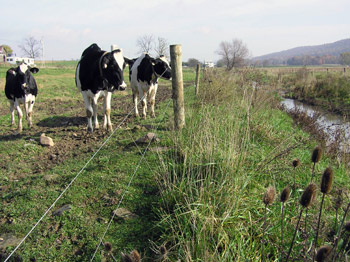CONSERVE | FALL 2008
A Fishing Fable
By Nick Pinizzotto, Senior Director, Freshwater Conservation
There once was a 12-year old boy named Chet who
lived on a dairy farm in Indiana County. He loved to
fish, but growing up on his family’s dairy farm meant
chores at daybreak, school and then more chores waiting
for him when he got home.
Each morning, the rooster ordered Chet out of his bed
and into the overalls and rubber boots he laid out the night
before. Leaning close to his dresser was a worn out
fishing rod with an antique reel, half-filled with old line.
Outside his door, he kept an old coffee can full of worms
and a retired miner’s lunchbox that served as a tackle box.
 A couple of years back Chet and his dad were able to
grab a few minutes together at the beginning of the day
and hiked to a neighbor’s pond where they fished for a few
moments as the sun came up. Chet’s family has a pretty
sizeable stream flowing through their pasture, but there
were never any fish in it because there weren’t any trees
around to cool the water and they had an ongoing problem
with Holsteins regularly finding their way down the banks
and into the stream.
A couple of years back Chet and his dad were able to
grab a few minutes together at the beginning of the day
and hiked to a neighbor’s pond where they fished for a few
moments as the sun came up. Chet’s family has a pretty
sizeable stream flowing through their pasture, but there
were never any fish in it because there weren’t any trees
around to cool the water and they had an ongoing problem
with Holsteins regularly finding their way down the banks
and into the stream.
Last summer, Chet’s father worked with WPC, county
conservation officials and the local conservancy to remove
his cattle from the stream, repair the stream banks, and
make other positive changes around the barnyard to buffer the stream from manure and other pollutants. There was
a lot of planning and several meetings at the farm, and
eventually, the money was in place to do the work. With
the price of fuel and equipment significantly outpacing the
return on a gallon of milk, it was important that several
different Federal Farm Bill programs, as well as grants and
private dollars, helped finance the job.
A couple of months ago, while he was retrieving an
ornery calf, Chet noticed a pair of nesting mallards in the
high grass that was growing just inside the fence that
lined the stream banks. When he moved in to get a
better look, he saw that distinct flash of light in the water
that every fisherman recognizes immediately as fish
darting for cover. He had never seen
fish in his stream before, and he
wasn’t sure if he really had now. He
raced back to the house, explained
what he thought he just saw and
pleaded to get out of milking the next
morning to try and fish his stream,
using his solid report card as a
bargaining chip. The next morning, he
and his father were catching fish out of
their own stream. Even though they
were just common creek chubs and
suckers, it was a start and neither
fisherman was complaining.
Chet looked forward to many
moments like this and he told his dad
he was going to do all he could to
protect that stream. He said maybe
someday he and his children would be
sitting in the same spot catching brook
trout right there on his family’s farm.
The Western Pennsylvania
Conservancy’s Freshwater Conservation
Program works closely with
farmers across the region, to promote
conservation practices designed to
protect sensitive waterways. This work
often includes devising a plan to pay
for the project using a variety of state
and federal programs, and private
funds. When staff members visit a
farm to discuss potential pollution
issues with a landowner, they also bring the solution. In
most cases, that solution includes the funding to implement
the plan. Since 2001, more than 80 miles of
streambank fencing has been installed, dozens of stabilized
stream crossings and alternative watering sources
have been developed, and thousands of acres of warm
season grasses have been planted. Working with county
conservation district and U.S. Department of Agriculture
officials, the Freshwater Conservation Program offers a
comprehensive suite of services to farmers that help
improve and protect water quality.

